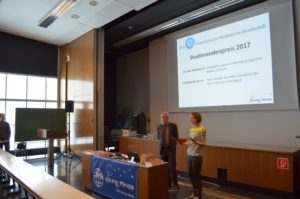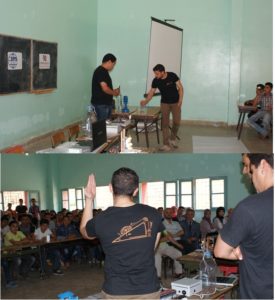 Mghila Béni Mellal USMS section has set up several activities during the 2017. First, visits to schools in Beni Mellal region and the realization of solar tracer project.
Mghila Béni Mellal USMS section has set up several activities during the 2017. First, visits to schools in Beni Mellal region and the realization of solar tracer project.
The focus of our activities is the transmission of technology to high school students and author people, and to show them how they can make practical works and technical projects with simple components and low cost.
First, we have visited a high school in AitAtab (Beni Mellal) and organizing a workshop of science and technology, in this workshop, we try to approach young minds students to technology and how to make a project with simple components and simple acknowledge. These projects are Cnc plotter, line tracer robot, robotic arm, alarm system. We have also visited another school in Fkih Beni Salh, where we organized a great event for more than 300 students from different levels. The objective of this event is show to student how to make a station to measuring some physical magnitudes, and use these measurements to make some simple project. For example Temperature measurement, this system is used to measure the temperature is composed by temperature sensor, Arduino board and an interface to visualize the results, we usually used LabViwe software. An author example is the radiation measurement this system is used to measure the solar radiation by using solar cells sensor.
The students shown great interest in the experiments and greatly thanked our visit, these students really got involved in the activities and due to that, we think they have learned many things. We considered this a very fruitful visit, were we gained also experience in presenting for large audiences.
The second Activity is the realization of a mono-axial solar tracker. The technique used for this study is based on the incident light difference on light-dependent photoresistor (LDR) sensors separated by opaque walls and placed on the PV panel. The control and control circuit performs the function of comparing the signals emitted by the sensors by calculating their differences, and then sends impulses back to the motor to reposition the panel perpendicular to the solar rays. We used in the realization of this project a stepper motor a support of two panels a control circuit composed of an Arduino acquisition card and two photoresistances.
Night events with DTU-Lys
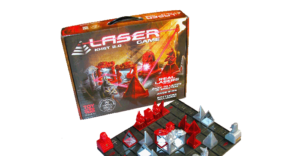 On November 28th 2017 in the evening, our student chapter DTU-Lys held a competition in the board game KHET, which is a complicated form of Chess, but with laser beams. Our student chapter owns 4 of these board games – a perfect number for hosting a competition with both group stages and knock-out rounds! The winner of the tournament was on beforehand promised a DTU-Lys t-shirt, which we had recently acquired a number of for outreach purposes. In total, this evening event numbered around 30 participants, with a good mix of Master students and PhD students.
On November 28th 2017 in the evening, our student chapter DTU-Lys held a competition in the board game KHET, which is a complicated form of Chess, but with laser beams. Our student chapter owns 4 of these board games – a perfect number for hosting a competition with both group stages and knock-out rounds! The winner of the tournament was on beforehand promised a DTU-Lys t-shirt, which we had recently acquired a number of for outreach purposes. In total, this evening event numbered around 30 participants, with a good mix of Master students and PhD students.
The evening started out with a 15 min introduction to our student chapter DTU-Lys, who we are, what we have done, and what plan to do. With the event taking place only half a month from our annual meeting and election in December, it was our hope, and plan, to lure in new potential active board members of DTU-Lys. Our current board now counts 4 new members who all participated in this event.
After the introduction, we divided people into four groups who were to play each other in order to decide who advanced from the group-stage and into the knock-out stage. We used chess-clock apps on our phones to make sure that the games did not continue in all eternity (this was an issue in the beginning) and to add an extra stress factor. During the night people had free access to beers and sodas, and after 1½ hour of playing everyone sat down and had pizza together.
All-in-all it was a very fun and social evening, and many of the participants urged us to organize a similar event in the spring 2018 – which we will certainly do!
Physics for High School Students
The Austrian section of EPS Young Minds (ÖPG Young Minds) and the Division “Physics and School” of the Austrian Physical Society (ÖPG) have organized this year’s “LehrerInnentag” (teachers’ day) of the Austrian Physical Society. We presented the winners of this year’s Students’ Award for outstanding master and diploma theses in the areas of theoretical and experimental physics, which is awarded by the Young Minds section. This year’s laureates are Lukas Semmelrock (HEPHY/TU Wien) for his work “Dissipative Losses in Self-Interacting Dark Matter Collisions” and Raphaela Wutte (TU Wien) for her work “Near Horizon Boundary Conditions for Spin-3 Gravity in Flat Space”.
Further, the division “Physics and School” presented the winners of the Roman Ulrich Sexl Award for outstanding achievements in teaching and the winners of the awards for “pre-scientific work” (“Vorwissenschaftliche Arbeiten”) in the area of physics.
Following the award ceremony, all laureates presented their areas of research in front of an audience of high school students. During the discussion many interesting questions were asked. Additionally, the participants of both the International Physics Olympiad (IPhO) and the International Young Physicists’ Tournament (IYPT) shared their experiences during these events.
With over 190 attendants composed mostly of high school students, teachers and other interested participants, the event was a great success. It connected graduate students and high school students and it helped introducing the latter to the forefront of research in modern physics. We definitely plan to repeat this event in the coming year.
Visit to the Scottish Dark Sky Observatory
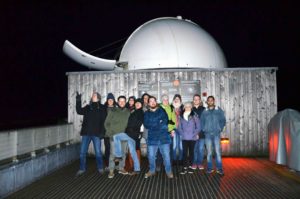 On November 18th, SCOPE organised a night trip to the Scottish Dark Sky Observatory (SDSO) located in the edge of the Galloway Forest in Ayrshire.
On November 18th, SCOPE organised a night trip to the Scottish Dark Sky Observatory (SDSO) located in the edge of the Galloway Forest in Ayrshire.
During this visit twelve of our members had the chance to visit the SDSO centre and enjoy their indoors exhibition together with an astonishing sky observation outdoors allowed by the clear skies during the visit.
The observation was guided by two members of the SDSO staff that were operating two telescopes, one of which was inside an impressive 5 metre dome. With the mentioned equipment, we were able to observe some of the major objects in the Northern Hemisphere night sky including major constellations such as Cassiopeia, Orion or Pegasus, some galaxies like Andromeda, and even the planet Uranus.
During the observation we also received interesting explanations not only regarding the astronomical objects we were looking at but also about the process of observation itself. Moreover, we had the chance to practice night photography with some of our cameras and the help of the members of SDSO and their tripods.
After this, we visited the exhibition inside the SDSO centre that included some models of planets, astronaut missions and some Physics demonstrations.
We consider that this trip was a fantastic opportunity for SCOPE members to learn about Astronomy and the local facilities that currently exist in Scotland for this purpose. Moreover, we gained awareness about issues like light pollution that obstruct observation.
Finally, we would like to mention that this activity was also aimed to show SCOPE members that there are many career possibilities with a background of physics outside Academia, such as outreach in Astronomy.
Career Evening
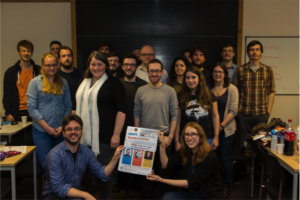 After a very successful first run last year, we wanted to repeat our SCOPE Career Evening which took place on October, 24 2017.
After a very successful first run last year, we wanted to repeat our SCOPE Career Evening which took place on October, 24 2017.
Three speakers, with a PhD in a natural science subject and a relation to Strathclyde University – either through their current job or past studies -, were invited. While the event last year was dominated by alumni working in the field of photonics, we wanted to mix things up more this year and hence, through successful internet searches, were able to engage a university lecturer with a research fellowship, an outreach officer and a business development manager to join us for the evening.
Each of the three gave a 15-20 minute presentation about their career path, their current positions and the career advice they gathered along the way and wanted to share with us. The talks turned out to be as varied as the speakers are: firstly in form, as they ranged from PowerPoint presentations to simply talking to us with some outreach props. But also in terms of content, we were able to gather both very practical career advice as well as more inspirational insight into how careers can develop and what aspects we should consider in our choices.
Finally, the evening was completed with a question and discussion round with all three speakers, before we finished off with a small reception during which speakers and audience could mingle a little more.
The audience consisted mostly of postgraduate students with some undergraduate students also attending and amounted to approximately 20-25 people. The feedback we received was overall positive and we take it as a positive sign that there was very lively discussion until the end of the evening.
Recruitment event
 As part of a developing SCOPE tradition, we welcomed, on October, 12 2017, new and not so new students to SCOPE with a start-of-the-semester social night.
As part of a developing SCOPE tradition, we welcomed, on October, 12 2017, new and not so new students to SCOPE with a start-of-the-semester social night.
Thanks to our EPS Young Minds grant, we were able to provide some food and drinks for the event and attracted about 30-35 students to our department’s common room in the evening. We started off with a short introduction to our student chapter and the activities that we are involved in during the year, in particular the upcoming chapter committee elections which was the centre of our recruitment efforts of the night.
After this official beginning, the rest of the evening was focused on networking, meeting and exchanging experiences with other students within the university. For the SCOPE committee, it was particularly also a good opportunity to find out more what kind of activities our members are interested in.
Throughout the night, we distributed our chapter business cards and had information and sign-up sheets for our mailing list displayed to fill in.
Although still a bit early to tell – as elections have not taken place yet -, our recruitment evening was very successful. A large number of new PhD and Master students attended with some very interested in our activities and how to officially join the chapter. A small number of undergraduate students also attended the event; this is a very positive sign, as we have recently increased our collaboration with the very undergraduate-oriented Physics Society at Strathclyde University in order to broaden our membership base further.
Overall, around ten people signed up to join our mailing list with some also already attending our follow-up event to the Welcome Night, a Career Evening at the end of November. As most current members of the SCOPE committee will step down this year due to their studies coming to an end, this event was very important for us in order to increase SCOPE’s visibility among students and ensure that we can find enough members for the new committee; we hope to have succeeded in this goal.
Spreading Optics through the University
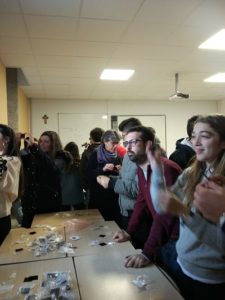 One more year, the USC EPS Young Minds Section devotes its efforts in outreach activities, focused in particular on the youngest. During this period, we have organised visits oriented to students of different local schools. The section members have gone to their classes and also the children have come to the Optics Faculty from University of Santiago de Compostela. In both situations, concepts explained to them were the same but the visit to the Faculty seems to be more enlightening due to the fact that they are able to visit the installations of the University as well as real Optics laboratory. Different research lines, where the YM Section members are involved, are shown to them and also the equipment of the laboratory and their basic functioning, such as pulsed lasers. The activities were distributed in four main blocks, as it was proposed in the Activity “Spreading Optics through the University” in the previous report. Nevertheless, the activity of holograms has been replaced for another one due to the material that was available in that moment. The performed activities were (1) polarization, (2) lens, (3) fluorescence and (4) refraction and reflexion. In (1), two little polarizers were given to the students to explain the concept, as well as a piece of a plastic fork to perform a tension essay using polarization. In (2), using a special kit of lenses and a schematic image of the human eye, myopia and hyperopia, as well as how they are corrected, were explained. In (3), we employed laser pointers, fluorescent markers, olive oil and gummies for explaining fluorescence and the light matter interaction. Finally, in (4) laser pointers, a methacrylate block and optic fibres were used. The main part of the budget has been employed in the bought of new material for the activities.
One more year, the USC EPS Young Minds Section devotes its efforts in outreach activities, focused in particular on the youngest. During this period, we have organised visits oriented to students of different local schools. The section members have gone to their classes and also the children have come to the Optics Faculty from University of Santiago de Compostela. In both situations, concepts explained to them were the same but the visit to the Faculty seems to be more enlightening due to the fact that they are able to visit the installations of the University as well as real Optics laboratory. Different research lines, where the YM Section members are involved, are shown to them and also the equipment of the laboratory and their basic functioning, such as pulsed lasers. The activities were distributed in four main blocks, as it was proposed in the Activity “Spreading Optics through the University” in the previous report. Nevertheless, the activity of holograms has been replaced for another one due to the material that was available in that moment. The performed activities were (1) polarization, (2) lens, (3) fluorescence and (4) refraction and reflexion. In (1), two little polarizers were given to the students to explain the concept, as well as a piece of a plastic fork to perform a tension essay using polarization. In (2), using a special kit of lenses and a schematic image of the human eye, myopia and hyperopia, as well as how they are corrected, were explained. In (3), we employed laser pointers, fluorescent markers, olive oil and gummies for explaining fluorescence and the light matter interaction. Finally, in (4) laser pointers, a methacrylate block and optic fibres were used. The main part of the budget has been employed in the bought of new material for the activities.
The activity has taken a very good reception from the students, due to its versatility and the self-made experimentation that they are able to do in each block. Also teachers consider an interesting activity because it is focused in science while it is very common to find activities focusing on Arts or humanistic fields in the surroundings. A prove of the success of the activity is the fact that last year schools ask for information to repeat the activity. In conclusion, we consider that this activity has enough impact to be done several times per year.
EPS YM recruitment social-evening “Go Fish for EPS-YM Members”
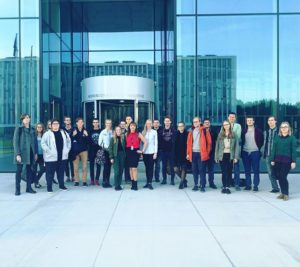 On October 18th European Physical Society Young Minds Section of Center for Physical Sciences and Technology (CPST) & Vilnius University (EPS YM Vilnius) together with SPIE and OSA student chapters (Vilnius) organized informational meeting for students from Faculty of Physics (Vilnius University). EPS YM Vilnius held recruitment event to encourage new members to join our chapter. CPST provided auditorium and basic equipment for presentations and meeting.
On October 18th European Physical Society Young Minds Section of Center for Physical Sciences and Technology (CPST) & Vilnius University (EPS YM Vilnius) together with SPIE and OSA student chapters (Vilnius) organized informational meeting for students from Faculty of Physics (Vilnius University). EPS YM Vilnius held recruitment event to encourage new members to join our chapter. CPST provided auditorium and basic equipment for presentations and meeting.
At the informational meeting EPS YM Vilnius chapter presented its main goals and activities. We presented a group of students from university and CPST, who assemble to organize activities related to the involvement with scientific community, promotion of science among local communities. We discussed with students about our events and events that we contributed to organize like International conference for students of physics and natural sciences “Open Readings”, “Sunrise Valley Semiconductor Seminars”, “10th Lithuanian Π day championship”, “Modern density functional theory – from physics to coding” workshops, workshops “What’s hot in the science publishing: the scientists’ approach”, etc.. We wanted students to learn more about the mission and vision of EPS YM.
The meeting was used to welcome, acquaint, inform, motivate, and engage new members. To illustrate how the Section operates, each our member has given a short overview. After presentation social-evening “Go Fish for EPS-YM Members” with pizzas has been organized at coffee house “Kino studija” (near the Faculty of Physics). Some of our members and chapter alumni told the students how EPS YM works, that we want to build a comaraderie around a shared passion. 8 students joined us. Our chapter wants to maintain strong and active. EPS-YM Vilnius set up and established a presence on a Facebook: https://www.facebook.com/EPSYMVilnius/
20 year anniversary
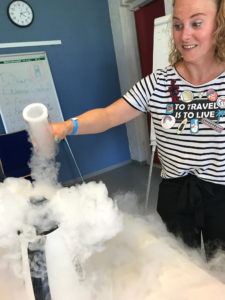 To celebrate the 20th anniversary of our foundation, we organized several activities for our members and for our contacts. We have organized a family-day, where the volunteers of our foundation had the opportunity to show what they have been doing to their parents and siblings. There has been a reunion for all the old members of the foundation and an almanac was made summarizing the past 5 years of our foundation.
To celebrate the 20th anniversary of our foundation, we organized several activities for our members and for our contacts. We have organized a family-day, where the volunteers of our foundation had the opportunity to show what they have been doing to their parents and siblings. There has been a reunion for all the old members of the foundation and an almanac was made summarizing the past 5 years of our foundation.
The family-day was a big success. As mentioned, all of the parents and siblings of the members were invited. We performed our Freezing Physics-show, the liquid-nitrogen-show that is traveling to high schools in The Netherlands to show that physics more than hard equations. The parents and siblings were also allowed to play with liquid nitrogen. A picture of an attendee (my own sister) is attached.*
The reunion was really fun and we think it was especially fun for our older members, most of them are not students anymore. There were also two of the founders at the reunion, which was a lot of fun for them. They didn’t know ‘their’ foundation still existed. A histogram is attached to show who were present at the reunion.*
We are very proud of our almanac. It cost a lot of work for the committee that was formed to produce it, but it was all worth it. Thanks to the Young Minds Grant it was possible for us to produce it for all of our members and contacts.
The family-day, reunion and almanac really made the 20th anniversary of the foundation an extraordinary year, for which we’re also thanking to the Young Minds Grant.
Get-Together-Meeting, Researchers Night and much more
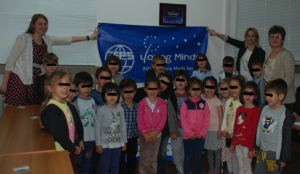 At the beginning of 2017, our newly formed section organized a Get-Together-Meeting, inviting the local SPIE and OSA chapters to present its proposed activities for 2017 and to extend an invitation to join the INFLPR YMS.
At the beginning of 2017, our newly formed section organized a Get-Together-Meeting, inviting the local SPIE and OSA chapters to present its proposed activities for 2017 and to extend an invitation to join the INFLPR YMS.
In February, our section has been invited by the Former President of the Romanian Physical Society to attend the meeting organized by the EPS-EC and EPS-CEI, taking place in Bucharest. This event presented great occasion for our section to be introduced to the public. The President and Vice-President of our section participated at the meeting, presenting the 1st Announcement of the sections’ international student conference, thus delivering the information to many EPS Member Societies.
Throughout the year, the INFLPR YMS organized laboratory visits at the National Institute for Laser, Plasma and Radiation Physics for kindergarten, primary, middle and high school pupils, thus providing participants an insight of the current scientific work carried out in the institute, and in the same time encouraging them to choose a career in research or academia. The President of the section also arranged small physics experiments, providing simple and concise explanations regarding fundamental physics phenomena in a funny and interactive way. It also has to be mentioned that in 2017, for the first time, INFLPR opened its doors for foreign students and their teachers from Germany.
Furthermore, a representative of the INFLPR YMS had the chance to attend the 6th Young Minds Leadership Meeting, organized in Naples, Italy, during 12-13 May 2017. He had the opportunity to make new connections and to advertise our student conference.
The INFLPR YMS was proud to organize together with the local OSA and SPIE chapters IONS® Balvanyos 2017, representing on one hand a huge commitment and responsibility, while on the other hand an incredibly worthwhile experience. IONS® Balvanyos was a memorable conference for all of us with high quality scientific program, opportunities to meet and discuss, as well as a truly enjoyable woodland experience. The conference was held at a geographically unique and vibrant resort in the heart of Transylvania’s Eastern Carpathian Mountains, near Lake Saint Ana, the only volcanic lake in Romania. IONS® Balvanyos brought together 65 participants from 10 different countries. Our generous partners and sponsors, including EPS as well, allowed us to offer Travel Grants to 18 students. The event didn’t lack of social activities, such as icebreaking games, field trip, playing Frisbee and campfire. The most courageous attendees also could take part in “bear watching”.
Moreover, the INFLPR YMS participated at Researchers Night in Bucharest, involving physics related experiments and providing visitors with funny and friendly explanations. Another aim of our participation was to promote and bring into the public attention the section and its activities.
Last but not least, at the beginning of 2018 our section launched a photo contest. Youngsters are asked to capture the beauty of science. With the help of the photo contest, our section will try to address people with various background and interests, showing the intertwining fabric of science and arts.

